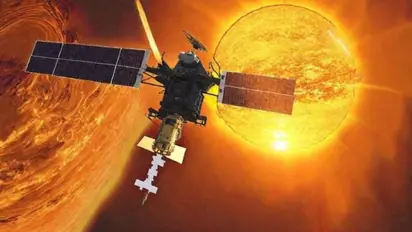Aditya-L1 reaches solar destination: PM Modi commends landmark achievement

Synopsis
Positioned at L1, an area where Earth and Sun's gravitational forces balance, the spacecraft aims to explore solar phenomena and storms, equipped with 7 specialized instruments. This location offers an unobstructed and advantageous perspective of the Sun for comprehensive study.
In a momentous announcement on Saturday (January 6), Prime Minister Narendra Modi hailed India's monumental achievement as the nation's inaugural solar observatory, Aditya-L1, reaches its celestial destination. The successful arrival of Aditya-L1 marks a significant milestone, showcasing the unwavering dedication of our scientists in accomplishing one of the most intricate space missions.
Extending congratulations to the team, PM Modi expressed his pride in this exceptional feat and affirmed India's commitment to explore new scientific horizons for the betterment of humanity.
The Aditya-L1 mission took off on September 2 aboard the PSLV, embarking on a significant journey towards its ultimate destination, the Sun-Earth Lagrange's Point 1 (L1), beginning its quest on September 19.
Indian pharma grapples with new standards post overseas drug-related deaths
Positioned at L1, an area where Earth and Sun's gravitational forces balance, the spacecraft aims to explore solar phenomena and storms, equipped with 7 specialized instruments. This location offers an unobstructed and advantageous perspective of the Sun for comprehensive study.
However, the challenge lies not only in reaching L1 but also in maintaining the spacecraft's position in this delicate orbit. To ensure precise trajectory and stability, ISRO employs meticulous orbit determination techniques using mathematical algorithms and specialized software developed by URSC.
ISRO Chairman S Somanath highlighted, "...Once it reaches there, we will perform periodic manoeuvres to keep the spacecraft in the intended orbit."
Muslim women from Varanasi to carry 'Ramjyoti' from Ayodhya to Kashi in communal harmony mission
Aditya-L1 hosts seven payloads designed to scrutinize various solar layers, including the photosphere, chromosphere, and the outermost corona, utilizing electromagnetic and particle detectors. Four of these payloads are dedicated to direct solar observation, while the remaining three conduct in-situ studies of particles and fields at Lagrange point L1, benefitting from this unique vantage point.
Stay updated with the Breaking News Today and Latest News from across India and around the world. Get real-time updates, in-depth analysis, and comprehensive coverage of India News, World News, Indian Defence News, Kerala News, and Karnataka News. From politics to current affairs, follow every major story as it unfolds. Get real-time updates from IMD on major cities weather forecasts, including Rain alerts, Cyclone warnings, and temperature trends. Download the Asianet News Official App from the Android Play Store and iPhone App Store for accurate and timely news updates anytime, anywhere.